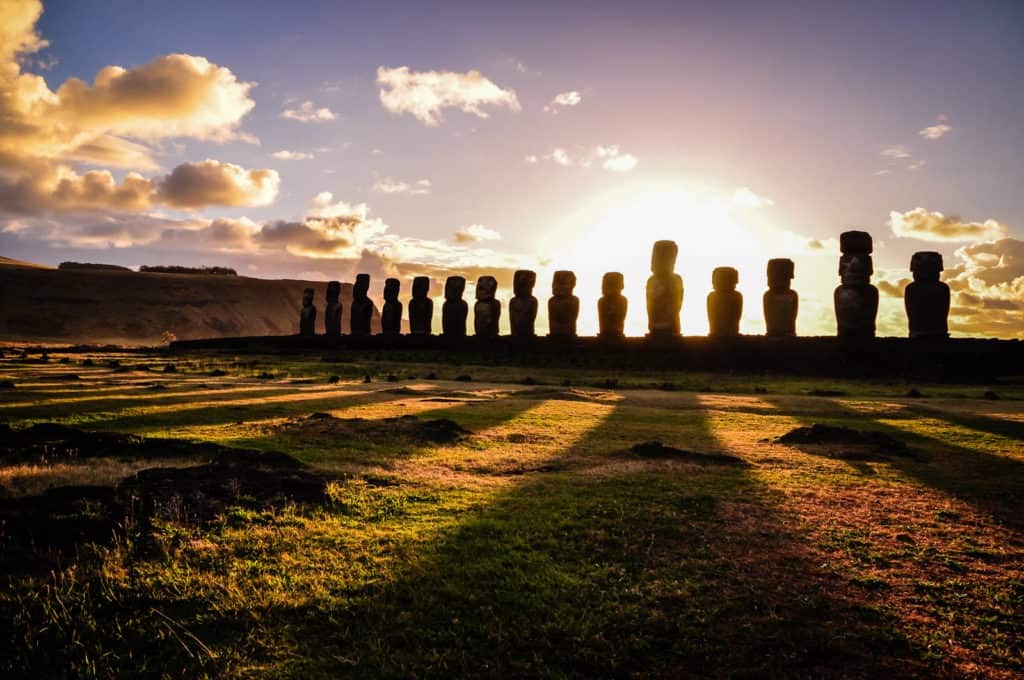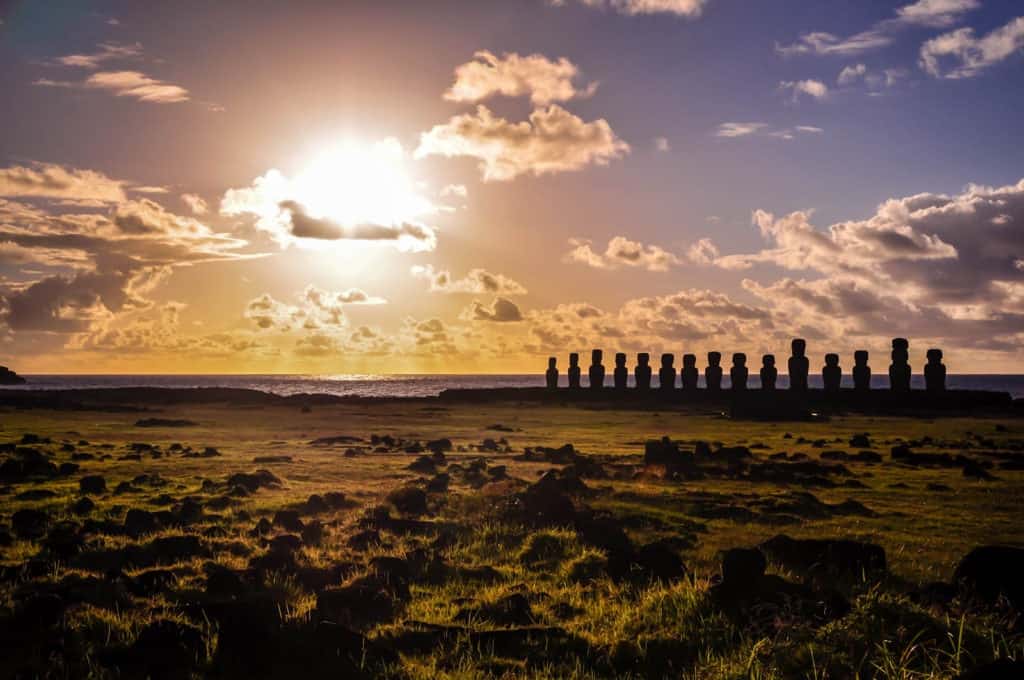Travel Guide | Easter Island | Chile
The mystical charms of Easter Island (Rapa Nui) and its Moai
Text | Anninka Kraus
Photography | Tobias Kraus

Chile
After more than a year traveling, we were for the first time upgraded to business class on an overbooked LAN flight from Santiago to Isla de Pascua Airport at Hanga Roa on Rapa Nui (the indigenous name of Easter Island). Indulging in priority boarding, we sipped orange juice and ate warm bread rolls while the poor fellas shuffled through our compartment on the way to economy. It was a delightful but rather short-lived 5-hour flight.
The route and destination however were unique. By the time we spotted the tiny light green speck of land dotted with volcanic craters and a small village, encircled by a shoreline of black volcanic rock, we had traversed the Pacific Ocean, and nothing but ocean, for hours.
Separated more than 3.500km from mainland Chile and more than 4.000km from Tahiti, Easter Island is among the most isolated places on Earth. Its remoteness has long held a magical allure for us though the island is in fact better known for its unique, enigmatic Moai status scattered about – monolithic humanlike figures carved from volcanic tuff.
Once on the island, the mystical charm was still present, but the view from the plane of an island lost in the vast expanse of ocean stretching to infinity with no land in sight highlighted its magic best.
When you visit Easter Island, the Museo Antropologico P. Sebastian Englert will help you better understand the history of this island. At least the little that is known about a civilization of Polynesian descent that flourished in the 17th century and declined along with environmental devastation, leaving behind toppled moai.
The question of how these giant Easter Island statues, ranging in height from 2 metres to 20 metres, were transported from quarries on the island and erected on ceremonial platforms, called Ahu, has led self-proclaimed explorers and researchers to indulge in the wildest fantasies.
Those suggesting aliens brought the statues along on space shuttles or that Rapa Nui warriors were related to Obelix had surely sipped some magic potion or spent too much time in isolation on the island. Experiments have proven that a few people with ropes can easily move these large statues made of lightweight tuff (compressed volcanic ash) and are believed to symbolize important deceased ancestors and chieftains of the Rapa Nui whose aura they assumed in ceremonies.
The devastating decline of a once thriving civilization started in the early 16th century when the Rapa Nui, for unknown reasons, renounced the ancestral worship through moai and established the Birdman Cult. Meanwhile extensive deforestation led to the depletion of natural resources and violent conflicts between hostile tribes ensued, giving rise to cannibalism and the systematic destruction of the cult complexes and moai by the Rapa Nui themselves. In the end not a single moai remained standing (in the 1950s the first were re-erected again).
Foreign diseases like flu and smallpox introduced by Europeans and kidnappings by Peruvian slave traders presumably brought about the final downfall of this people. By the late 19th century, the Rapa Nui had been extinguished save for little more than 100 people.
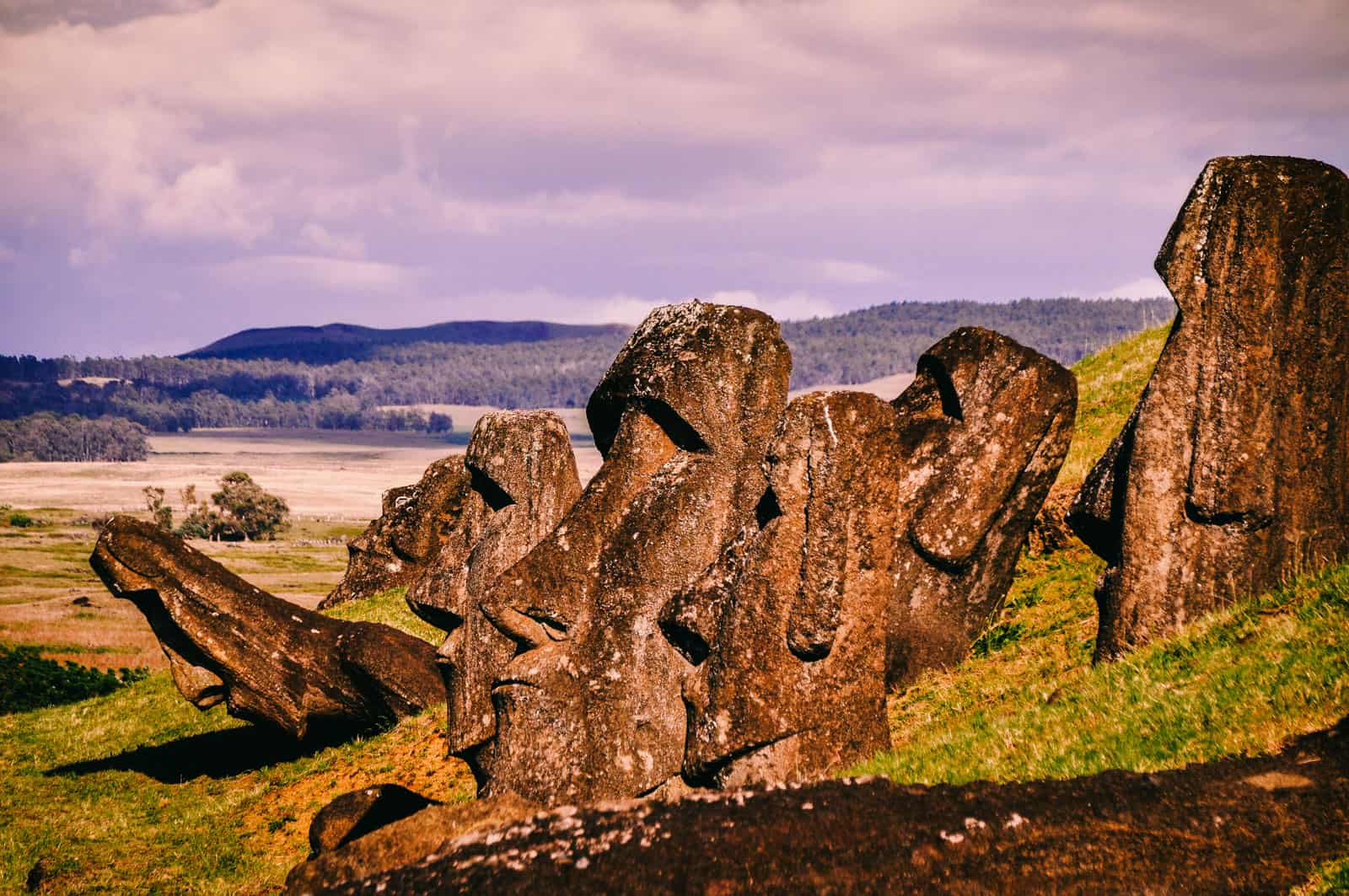
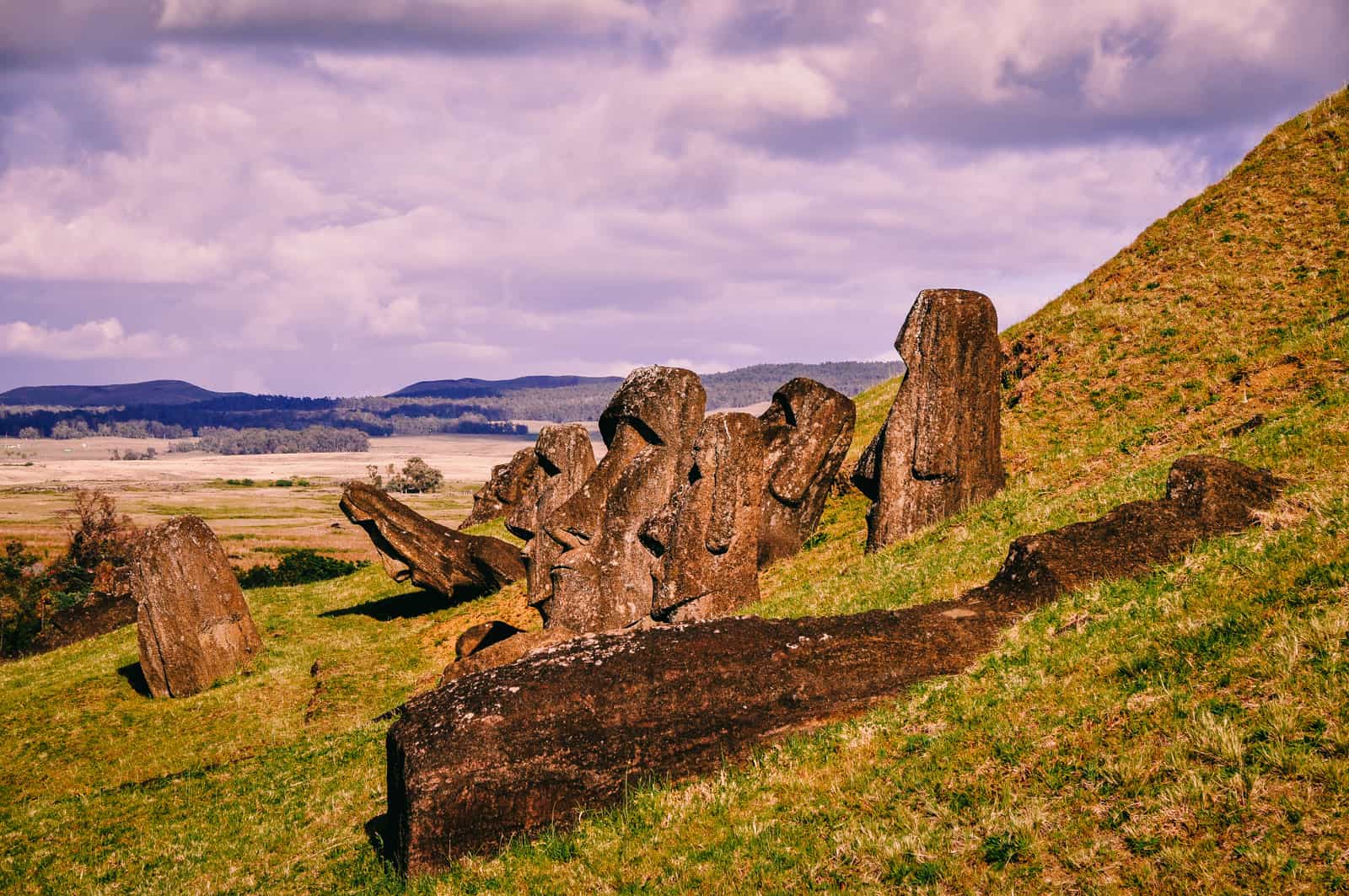
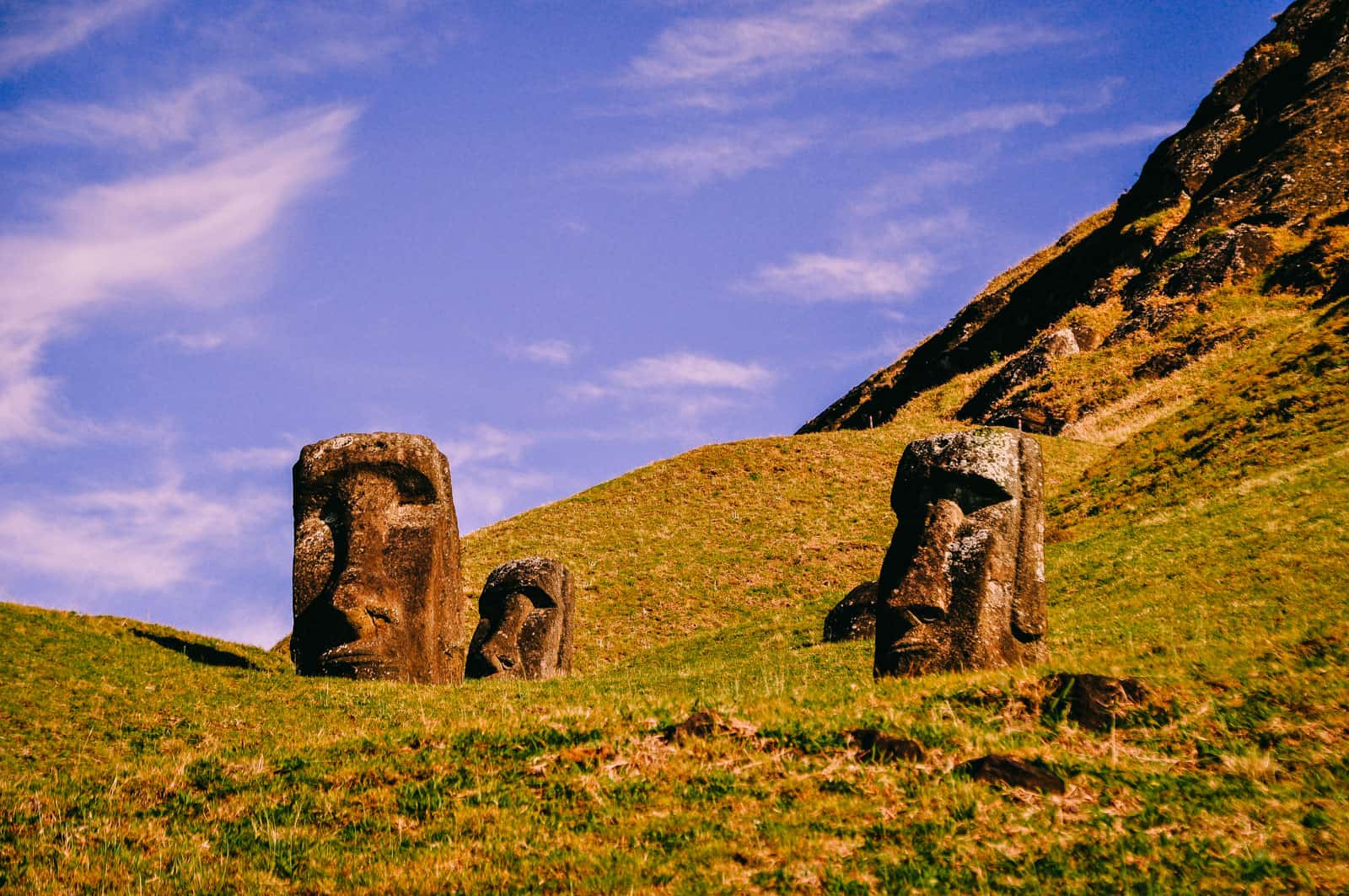

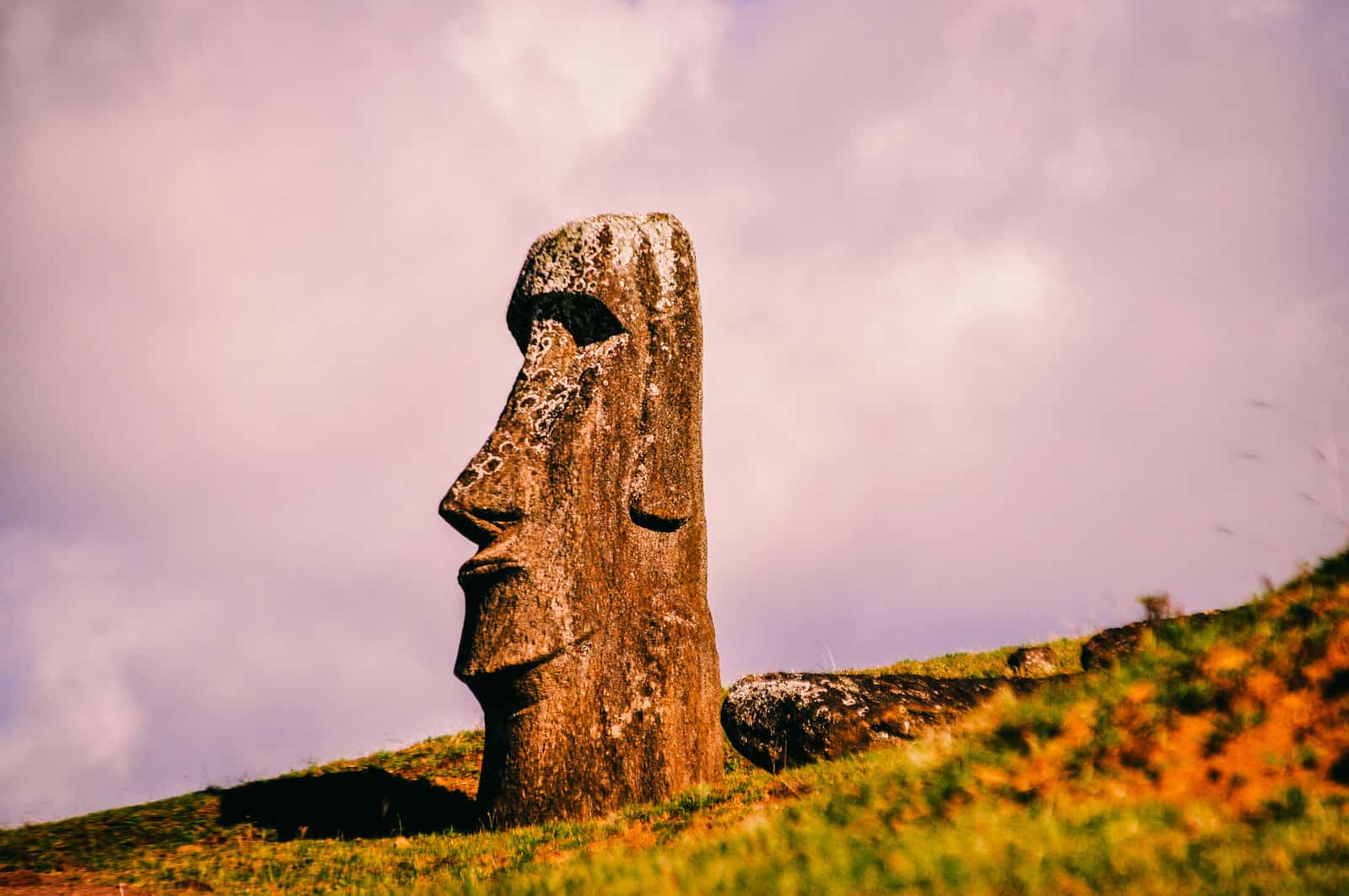


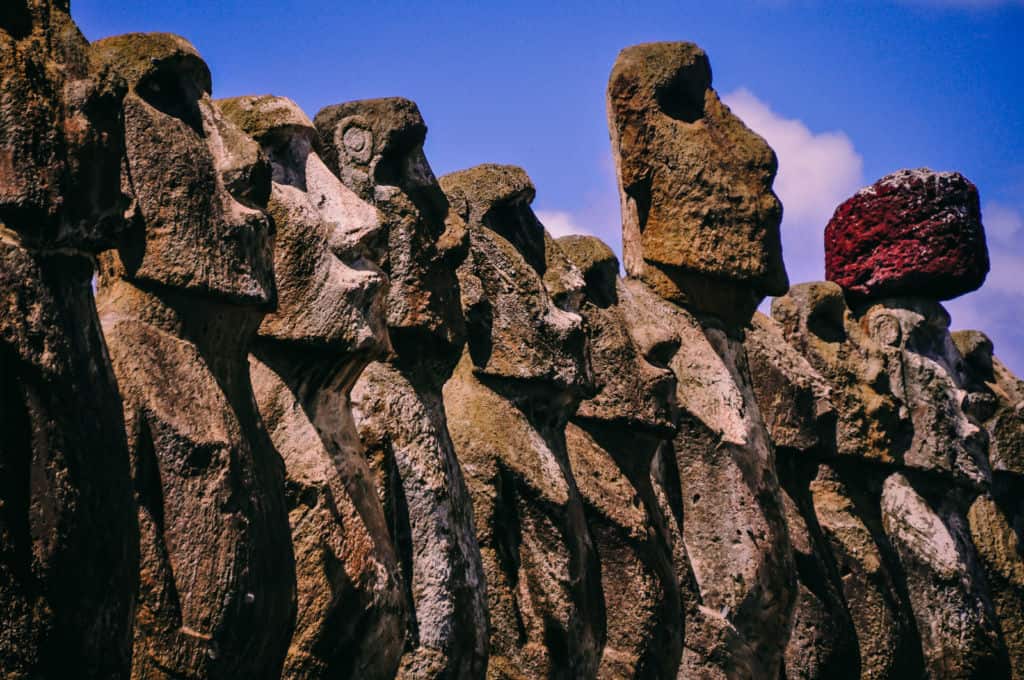
The island’s tragic past remained confined to the museum. Once we stepped outside, rented a small motorbike and explored the isle we were enthralled by the beautiful scenery it was endowed with. The climate of Easter Island is subtropical – mild and seasonal variations are minimal – but its hillocky grasslands stretching towards the shore closely resembled New Zealand and Ireland with temperate climates.
The gently billowing green canvas was traversed by black walls of volcanic rock and dotted with wild horses nibbling away on lush grass. The tranquillity however ended abruptly at the island’s shoreline. Waves several metres high split on rugged cliffs and millions of airborne water droplets were carried inland by the persistent wind and covered our lips with a salty film. The shoreline was ever present and it was only rarely that we couldn’t see, hear, smell or taste the raucous, salty mass of water surrounding Easter Island.
It was pitch black on our motorbike ride along the southern shore to watch the sunrise at Ahu Tongariki, the largest ceremonial platform on the island. We were the first to arrive and scrambled onto boulder of porous, sharp-edged volcanic rock waiting for sunrise in the damp chilly breeze that smelled of wet grass and saltwater. Not yet visible, the contours of large statues, blacker than the night sky, contrasted faintly. When gradually the sun moved towards the horizon the cloud cover on the far side of the platform was dyed a soft pink. Their outlines still blurry, we distinguished the silhouettes of fifteen statues.
As dawn succeeded darkness the sculptures profiled against the light and colour spectacle of dawn – small and large, fat and skinny moai lined up in a row, one balancing a dark red headdress, called pukao, on its oversized head. They gazed towards the interior of the island in pious immobility, their flat, erect backs turned towards the sea. Then the shadows disappeared from deep-set eye sockets on their faces and their coarse features – a pointed nose, broad, angular chin, and elongated ears – became clearer.
I cannot think of many moments that have imprinted themselves in my mind as firmly as the beauty of sunrises have – over the Annapurna Range surrounded by fluttering prayer flags and snow-capped mountains, in the Namib Desert sitting on dune 45 surrounded by red sand as far as the eye can reach, at Bryce Canyon as the sun’s rays like pale pink brush strokes transformed delicate limestone formations into fairy-tale castles, and here.
It’s an inspiring thought that these beautiful moments recur every day (with the exception of winter in Europe where an impenetrable cloud cover, fog, and mist in rotation ensure an unvarying palette of greys throughout the day for six months of the year), generally require little to no physical effort (besides getting up early which may indeed be an insurmountable challenge to some) and are free for everyone to enjoy. When at long last the sun rose above the cloud that had stubbornly persevered at the very edge of the horizon, the light, through gaps between the statues, spilled forward in long beams onto the hillside. The dappled stripes of Moais’ shadows and light filtering through between them painted an elongated duplicate profile of the ceremonial platform on the grass.
Minutes later it was light and other spectators headed back towards the village. We had brought along breakfast however and watched the brightness of daylight intensify, waves crash the shore, and wild horses trot past as the sun dispelled the last whiffs of chilly morning air. Two more ceremonial platforms are set against the backdrop of the ocean similar to Ahu Tongariki, smaller but no less formidable. One, Ahu Vai Ure, a platform with five moai close to Hanga Roa is a popular spot to watch the sunset. We were lucky the fleecy clouds of that morning had disappeared and watched the spectacle of a few hours ago in reverse order. The blazing colours of the sunset rivalled the subtle hues of sunrise in glory and by the time the sun plunged into the sea it was a deep red ball of fire.
This platform belongs to the Tahai Ceremonial Complex that also comprises two single moai close by; one rather eroded, on Ahu Tahai, and the other, on Ahu Ko Te Riku, splendidly restored with white replica eyes and a pukao. I was astounded how expressive and vivid even the face of a moai appeared with simple eyes.
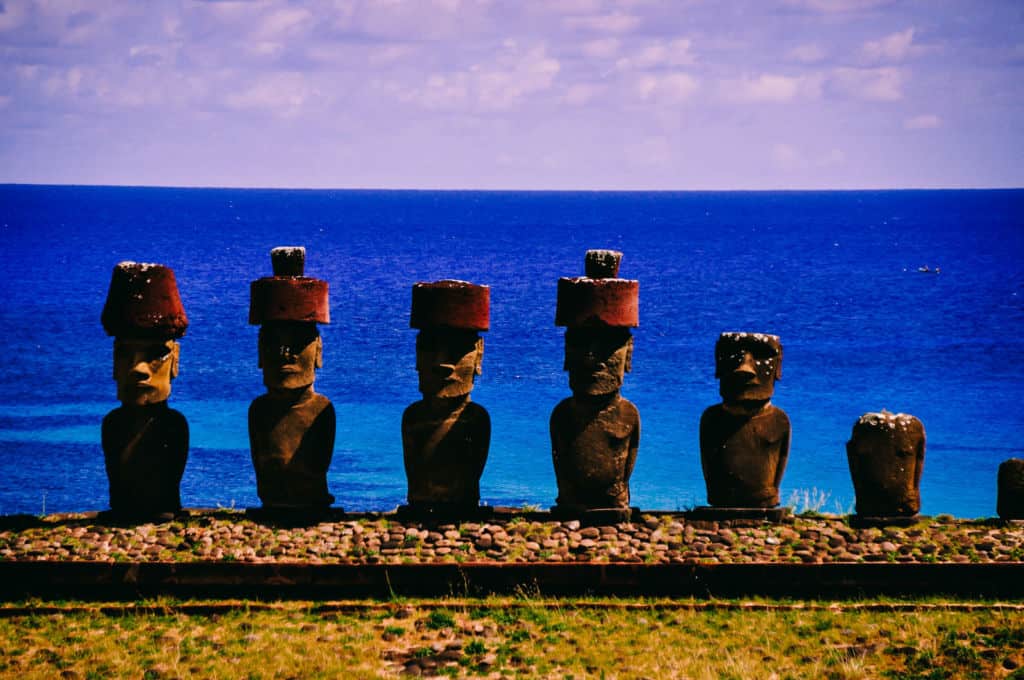
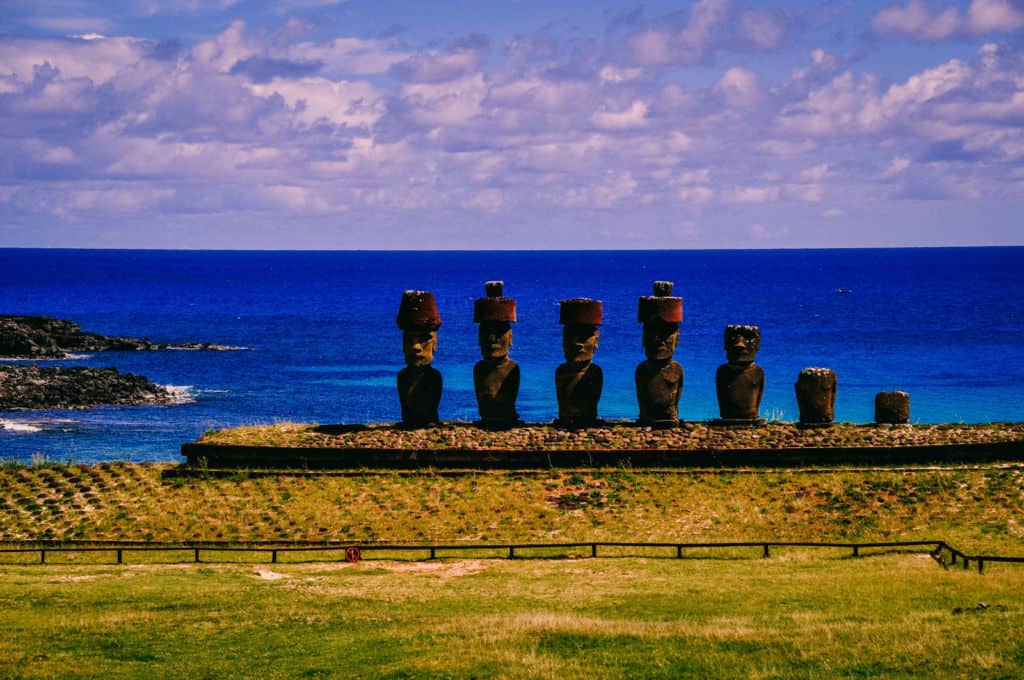
On the third and most exquisite platform, Ahu Nao-Nao at Anakena Beach, a half-hours drive northeast of Hanga Roa, seven moai, four featuring red headdresses, were lined up against the backdrop of a paradisiac, curving beach and turquoise sea that reminded me of the Seychelles and flanked by coconut palms.
A kindergarten group of little Rapa Nui was squealing with delight as they splashed about in the crystal clear turquoise water but, being four years old, paid no attention to the sculptures.
We spent days exploring the shoreline before climbing Maunga Terevaka, a volcano and the island’s highest point at 511 metres above sea level, which yet again visualized the remoteness we had longed for when traveling to Easter Island. At the top we sat on a gently sloping meadow and followed the rise and fall of sparsely populated green hills running down to the black-rimmed shoreline, and beyond the ocean reaching for the horizon in all directions. I squinted, narrowing my eyes to slits until the scenery blurred into only two colours – the ones predominant on Rapa Nui: the green of the hillside and the blue of the sky and ocean.
Cantera De Moai, an archaeological site on the extinct volcano Rano Raraku, was one of two sites within Rapa Nui National Park, a declared UNESCO World Heritage Site, that were subject to an entry charge. Raraku, the birthplace of all moai, is often referred to as the quarry. From here the statues were transported to various ceremonial platforms on the island, yet some 400 moai, sitting on the slopes of the volcano in various stages of completion that visualize the whole carving process, were either not finished or still awaiting transportation. Almost all sculptures were half-buried in the green hillside but even their elongated head dwarfed my own size. From afar merely large boulders, up close the weathered features chiselled into brown lava tuff testified to the talent of the ancient Rapa Nui society.
Orongo, the other site requiring a ticket to the national park (US$ 80 / valid 10 days), is a sacred ceremonial village that bears witness to the Birdman Cult, which replaced the cult of the ancestor in the late 17th century. More than fifty semi-subterranean houses built with basalt stone slabs, low-slung and windowless snuggle into the narrow rim of the Rano Kau volcanic crater that plunges steeply into the ocean below, in perfect harmony with the surrounding scenery. While the rock on this site was generously engraved with petroglyphs, mainly alluding to the birdman, Makemake, the creator of humanity and god of fertility, I was far more impressed by the obvious parallels of these dwellings with modern architectural features than their cultural and historical significance. I could picture an eco-friendly spa unobtrusively embedded in its surroundings with natural stone and grass roof, looking much the same.
Returning to Hanga Roa we stopped at Rano Kau viewpoint and sat on the crater rim gazing at the perfectly formed volcano, its walls sloping steeply and converging in a shimmering fresh water lake, covered by plants that looked much like grass and reed, at the bottom. The crater wall facing the ocean was noticeably lower than the rim facing inland. It looked almost as if the sea had taken a large bite and formed a natural window through which a strong wind swept across the exposed crater walls and rustled the short grass.
